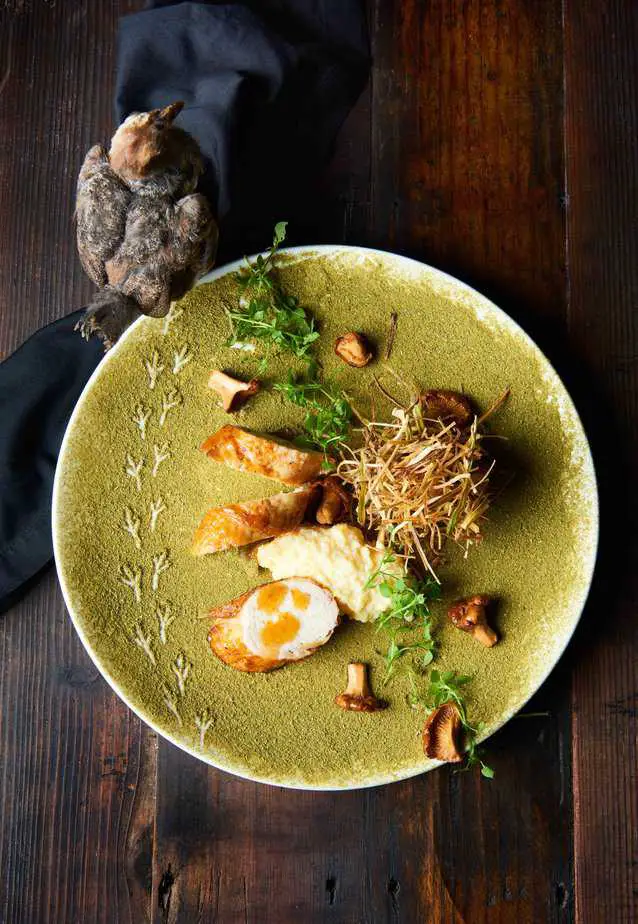Walking into Palette, I was already blown away just by how beautiful the space was. The main doors lead you into a grandiose dining room that comes together with a wood-burning brick oven at the center of their open kitchen with vibrantly painted murals on the walls. It was as if I stepped off the busy streets of SOMA straight into someone’s palace. It was clear that Chef Peter and his team have an immaculate attention to detail with custom hand blown glassware and hand painted plates to match each dish perfectly.
We had the chance to speak with Chef Peter and get to know in depth the ideas behind Palette.
Tell us your upbringing, where are you from and how did it shape you?
I grew up in Minnesota, Minneapolis suburban area with a certainly normal childhood. I have three siblings, two brothers and a sister. I had a very conventional childhood and I think my relationship with food and the desire to work with it came as a sort of a byproduct of my mother’s influence on me. She wasn’t a trained cook but she was very competent. She grew up in the Pennsylvania countryside with her parents of Slovenian heritage. Their lense was always sort of on country fresh vegetables, with a lot of meat, not a lot of fish. So she had that background applied with being a mother and raising kids in the late 80’s/early 90’s. My mother was an excellent home cook and always fed us well and that was a big part of my life. I’ve been drawing since I can remember so the art had always been there.
Which came first? Food or Art?
Food and art always came hand in hand but when it came to applying skill and thought in the preparation of food, it came later in high school and entering college years.
What influenced you to combine the two together? When did you have that ah-ha moment?
I started applying food and art together around 2011 with a series of drawings. I was learning French at the time and reading a ton of French food history books and out of that, I found these historic recipes that have brought their way into this general culture that we sort of take for granted and I found that fascinating to find where these recipes came from. That transitioned into a desire to story tell through a series of illustrations with colored pencils. I have six of them now, working on my 7th and these are the cornerstone series that this whole concept trickled out of. Coming back to the U.S. in 2014 (from working at 3-Michelin Arpege in Paris), I had two or three years of this type of work that I considered as a sideline hobby, I wasn’t sure where I was gonna apply it to, maybe I was going to put it in my restaurant one day or maybe it would just be a collection that would go in a book. But when I got back to the U.S. I realized while working at Quince and other fine dining restaurants, that there was something lacking in the experience for me of just sitting at a fine dining restaurant. Something just wasn’t enough. Sitting at a table for 4 hours and having 16 courses of excellently prepared food was overwhelming in some senses. It seemed like it was over saturating your palette and your stomach. For me, I wanted the experience to be more comprehensive. I wanted to curate an experience where you ate well but didn’t feel like you got over-satiated with your dining experience and walk away not being able to do anything for the rest of your evening. For me, that’s not the goal when you come in and eat at Palette. The goal is that you walk away really satisfied with your meal and you had a great experience.
How do you get inspired to develop new recipes? How do you stay fresh?
There’s a series of what I call “Chef Sketches” of just quick ink and watercolor jots on paper that are a vision into how I develop personal recipes. From the food perspective, it’s sort of an attempt to constructively build a personal collection of food, that doesn’t just include myself.
I allow my team to really apply their creativity and come up with recipes where they’re actively involved in the creation and curation of the food experience. It’s a dialogue between myself, the kitchen and the art element of coming up with ideas, applying the food product, giving it a name and having an artistic representation of what that is from a very literal perspective to the more abstract art rendition of it, which can be seen in our gallery.
Out of all the cities in the world, what made you choose San Francisco?
In 2014, I had spent the last 4 years working my way through kitchens in Paris. I was finishing off my experience at a 3 Michelin, L’Arpege and I had just gotten married to Marie, who I met while I was in Paris. I had my experiences in San Francisco and knew about the beauty and its tremendous resources for Chefs and restaurateurs. I knew it was a place I could bring Marie back and she would lock into it since there’s a huge French community here, about 100,000 strong. There was something about San Francisco and the cultural diversity and the fact that it’s tremendously beautiful. It’s hard to deny the Pacific Ocean and its climate.
// Palette is open Tuesday through Saturday (lunch service Tuesday through Friday 12 – 2pm). 816 Folsom St, SoMa, palette-sf.com; Photography courtesy of Palette SF.


